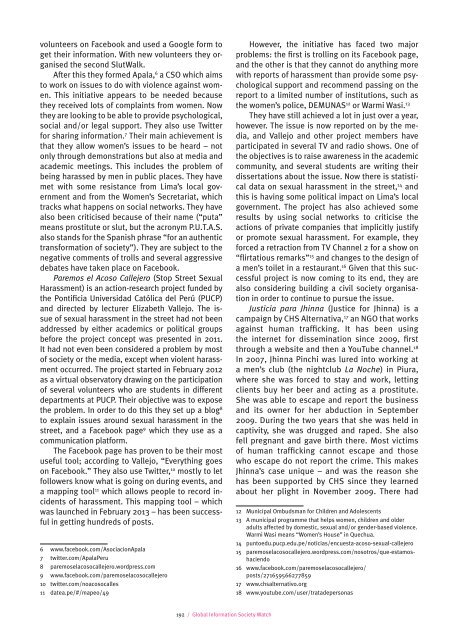gisw13_chapters
gisw13_chapters
gisw13_chapters
You also want an ePaper? Increase the reach of your titles
YUMPU automatically turns print PDFs into web optimized ePapers that Google loves.
volunteers on Facebook and used a Google form toget their information. With new volunteers they organisedthe second SlutWalk.After this they formed Apala, 6 a CSO which aimsto work on issues to do with violence against women.This initiative appears to be needed becausethey received lots of complaints from women. Nowthey are looking to be able to provide psychological,social and/or legal support. They also use Twitterfor sharing information. 7 Their main achievement isthat they allow women’s issues to be heard – notonly through demonstrations but also at media andacademic meetings. This includes the problem ofbeing harassed by men in public places. They havemet with some resistance from Lima’s local governmentand from the Women’s Secretariat, whichtracks what happens on social networks. They havealso been criticised because of their name (“puta”means prostitute or slut, but the acronym P.U.T.A.S.also stands for the Spanish phrase “for an authentictransformation of society”). They are subject to thenegative comments of trolls and several aggressivedebates have taken place on Facebook.Paremos el Acoso Callejero (Stop Street SexualHarassment) is an action-research project funded bythe Pontificia Universidad Católica del Perú (PUCP)and directed by lecturer Elizabeth Vallejo. The issueof sexual harassment in the street had not beenaddressed by either academics or political groupsbefore the project concept was presented in 2011.It had not even been considered a problem by mostof society or the media, except when violent harassmentoccurred. The project started in February 2012as a virtual observatory drawing on the participationof several volunteers who are students in differentdepartments at PUCP. Their objective was to exposethe problem. In order to do this they set up a blog 8to explain issues around sexual harassment in thestreet, and a Facebook page 9 which they use as acommunication platform.The Facebook page has proven to be their mostuseful tool; according to Vallejo, “Everything goeson Facebook.” They also use Twitter, 10 mostly to letfollowers know what is going on during events, anda mapping tool 11 which allows people to record incidentsof harassment. This mapping tool – whichwas launched in February 2013 – has been successfulin getting hundreds of posts.6 www.facebook.com/AsociacionApala7 twitter.com/ApalaPeru8 paremoselacosocallejero.wordpress.com9 www.facebook.com/paremoselacosocallejero10 twitter.com/noacosocalles11 datea.pe/#/mapeo/49However, the initiative has faced two majorproblems: the first is trolling on its Facebook page,and the other is that they cannot do anything morewith reports of harassment than provide some psychologicalsupport and recommend passing on thereport to a limited number of institutions, such asthe women’s police, DEMUNAS 12 or Warmi Wasi. 13They have still achieved a lot in just over a year,however. The issue is now reported on by the media,and Vallejo and other project members haveparticipated in several TV and radio shows. One ofthe objectives is to raise awareness in the academiccommunity, and several students are writing theirdissertations about the issue. Now there is statisticaldata on sexual harassment in the street, 14 andthis is having some political impact on Lima’s localgovernment. The project has also achieved someresults by using social networks to criticise theactions of private companies that implicitly justifyor promote sexual harassment. For example, theyforced a retraction from TV Channel 2 for a show on“flirtatious remarks” 15 and changes to the design ofa men’s toilet in a restaurant. 16 Given that this successfulproject is now coming to its end, they arealso considering building a civil society organisationin order to continue to pursue the issue.Justicia para Jhinna (Justice for Jhinna) is acampaign by CHS Alternativa, 17 an NGO that worksagainst human trafficking. It has been usingthe internet for dissemination since 2009, firstthrough a website and then a YouTube channel. 18In 2007, Jhinna Pinchi was lured into working ata men’s club (the nightclub La Noche) in Piura,where she was forced to stay and work, lettingclients buy her beer and acting as a prostitute.She was able to escape and report the businessand its owner for her abduction in September2009. During the two years that she was held incaptivity, she was drugged and raped. She alsofell pregnant and gave birth there. Most victimsof human trafficking cannot escape and thosewho escape do not report the crime. This makesJhinna’s case unique – and was the reason shehas been supported by CHS since they learnedabout her plight in November 2009. There had12 Municipal Ombudsman for Children and Adolescents13 A municipal programme that helps women, children and olderadults affected by domestic, sexual and/or gender-based violence.Warmi Wasi means “Women’s House” in Quechua.14 puntoedu.pucp.edu.pe/noticias/encuesta-acoso-sexual-callejero15 paremoselacosocallejero.wordpress.com/nosotros/que-estamoshaciendo16 www.facebook.com/paremoselacosocallejero/posts/27165956627785917 www.chsalternativo.org18 www.youtube.com/user/tratadepersonas192 / Global Information Society Watch


